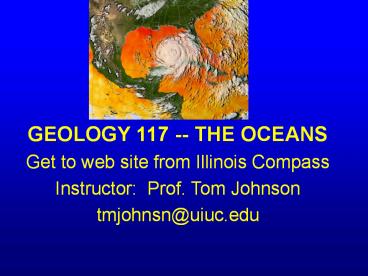Lecture 2 -- Geology 117 - PowerPoint PPT Presentation
1 / 40
Title:
Lecture 2 -- Geology 117
Description:
GEOLOGY 117 -- THE OCEANS Get to web site from Illinois Compass Instructor: Prof. Tom Johnson tmjohnsn_at_uiuc.edu P- waves (refraction, shadow zone) S- waves (blocked ... – PowerPoint PPT presentation
Number of Views:141
Avg rating:3.0/5.0
Title: Lecture 2 -- Geology 117
1
GEOLOGY 117 -- THE OCEANS Get to web site from
Illinois Compass Instructor Prof. Tom
Johnson tmjohnsn_at_uiuc.edu
2
Web Notes and Readings
- One set of notes for each class linked to class
schedule on web page - Short reading assignments to be done before
classes listed in class schedule on web page - Get to the web page through Compass
3
What is Science?
- A collection of facts about nature?
- -Its much more than that
- A process or method used to decide what is true
and what is not? - -It is that, too.
- A collection of ideas dreamed up by scientists
that keeps changing and is never really
reliable?.....
4
Science is often reliable.
5
- How science progresses, succeeds, and fails
- We observe the world around us.
- We try to make sense of it all. If we succeed at
that, then maybe we can predict what will happen,
or find a way to make something useful. - We make educated guesses- Hypotheses.
- Some dont hold up useless.
- Others do withstand the tests of time- useful!
- So we test them- BIG TIME
6
- How science progresses, succeeds, and fails
- Sometimes an idea becomes more than just an
educated guess. After much testing, it really
seems to work, and we call it a theory. Some
theories are well established and reliable.
7
- How science progresses, succeeds, and fails
- Sometimes an idea becomes more than just an
educated guess. After much testing, it really
seems to work, and we call it a theory. Some
theories are well established and reliable. - Some theories are revised or overturned
- - This does not mean that science is haphazard-
it is part of the normal process - - We will examine the development of the theory
of plate tectonics in this class.
8
Subdivisions of ocean science Marine
geology Chemical oceanography Physical
oceanography Biological oceanography This is the
basic order of topics in this course.
9
Class 2 -- Geology 117
- The Earth, Part 1
10
The Oceans- Part 1 Marine Geology
- How did the Earth and Oceans form?
- What does the ocean floor look like (shape)?
- Why is it shaped that way?
- Why does the earth have oceans and continents
instead of just a single shallow ocean covering
everything? - How do we know all this stuff anyway?
- Do we really know or is it more inference
than knowledge?
11
Latitude
Latitude lines are parallels constant
distance between
12
Longitude (East-West)
Why measure longitude in degrees???
13
(No Transcript)
14
(No Transcript)
15
(No Transcript)
16
(No Transcript)
17
(No Transcript)
18
(No Transcript)
19
Continents mostly in the N hemisphere Gives
Earth a slight pear shape
20
When did the earth form and how did it form? How
did it get to be what it is today?
- About 5 B.Y. ago Formation of the solar system
Gravitational collapse, rotating disk dust
and gas (mostly H and He) - Then accretion -- planets.
- Earth, other planets, meteorites at 4600 m.y.
- Early molten(?) stage of Earth (first 200 m.y.)
- - silicate mantle and metallic core formed
21
Layering of the Earth Based onChemical
Composition
22
(No Transcript)
23
(No Transcript)
24
(No Transcript)
25
Fig. 1.14 in Text
26
What is the evidence for this?
- The way earthquake waves travel through
- Each earthquake sends out waves
- Thousands of seismographs detect these
- e.g., Earthquake in Turkey, detected here
- Two types of earthquake waves
- compressional waves, or P waves
- shear waves or S waves
27
P and S wave material not in textbook
28
(No Transcript)
29
http//www.eas.purdue.edu/braile/edumod/waves/Pwa
ve.htm http//www.eas.purdue.edu/braile/edumod/w
aves/Swave.htm
30
P- waves(refraction, shadow zone)
S- waves(blocked by liquid, large shadow zone
Homogeneous earth would be like this
31
Homogeneous earth would be like this
32
(No Transcript)
33
P and S wave material not in textbookhttp//neic
.usgs.gov/neis/eq_depot/2002/eq_021103/ak_seismic_
waves.html
34
P- waves(refraction, shadow zone)
S- waves(blocked by liquid, large shadow zone
Homogeneous earth would be like this
35
More evidence used to infer whats inside the
earth...
36
(No Transcript)
37
(No Transcript)
38
More evidence used to infer whats inside the
earth...
- Meteorites
- Some are fragments of planets broken apart
billions of years ago - Some are Fe Metal
- Some are MgFe silicates like the earths mantle
39
How do we know when all this happened (age
dates)?
- Radioactive elements
- Decay produces daughter products
- Some radioactive elements have very long
half-lives (e.g., Uranium) - Buildup of daughter products can be used to
determine ages of rocks and meteorites
40
Represents amount of uranium
Represents amount of lead















![Who was this Donald Lee, the man who set power free? And, was there a "secret to his method", so to speak? [File 4 of 5] PowerPoint PPT Presentation](https://s3.amazonaws.com/images.powershow.com/9270440.th0.jpg?_=20190520016)















